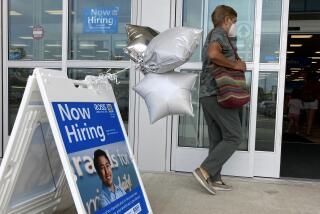U.S. Productivity Off 2.5% in 1st Quarter
- Share via
WASHINGTON — U.S. business productivity declined at a 2.5% annual rate in the first quarter of 1985, the most severe drop since the recession more than three years ago, the Labor Department reported Wednesday.
The report also showed that unit labor costs soared at an 8.1% annual rate, the largest increase since the fourth quarter of 1981, the department’s Bureau of Labor Statistics said.
The decline in productivity, meanwhile, also was the most drastic since the fourth quarter of 1981, when it dropped 4.4%, compared to the previous quarter.
The industrial sector, hurt by foreign imports, was cutting back production in the first quarter of this year immediately after hiring more employees based on last year’s generally solid performance by the U.S. economy, said David Jones, chief economist at Aubrey G. Lanston & Co.
The rise in unit labor costs suggests that the trade imbalance is “a potential source of reinflation, unfamiliar in origin, but that doesn’t mean it can’t happen,” said analyst Allen Sinai, chief economist at Shearson Lehman Bros.
Hours worked rose 3.3% while output rose just 0.8% in the first quarter. Earlier, the Commerce Department reported that the U.S. economy turned in an anemic growth rate of 0.7% during the first three months of this year, the slowest pace since the end of the 1981-82 recession.
The latest productivity figures reflect a general slowing down in the economy and also suggest some obsolescence in industrial plants and equipment, said analyst Michael Evans, who runs his own economic forecasting firm in Washington. Investment in new technology has been strong in computers and the auto industry while lagging in many other areas.
Poor productivity suggests lower profits or higher inflation, and “what we have seen in the first quarter so far is that profits took a real hit,” Evans said. Many firms were unable to pass along higher costs in the face of weak demand.
Evans suggested that companies will start passing along many of the cost increases as economic activity picks up. Analysts say that at least some pickup in activity appears likely, given actions such as the Federal Reserve Board’s move May 17 to lower the discount rate.
Wednesday’s seasonally adjusted figures represented a worse showing than last month’s preliminary data, which concluded that productivity in the first quarter fell 1.2% while unit labor costs rose 7.3%.
More to Read
Inside the business of entertainment
The Wide Shot brings you news, analysis and insights on everything from streaming wars to production — and what it all means for the future.
You may occasionally receive promotional content from the Los Angeles Times.









